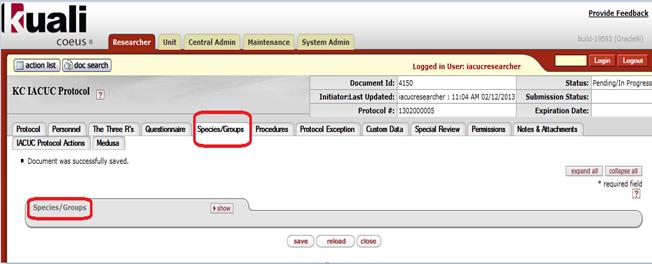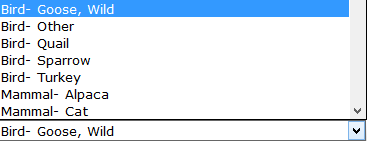Species/Groups
The Species/Groups page captures details of the Species of animals being used and the experimental group the species are part of. The investigator is asked for detailed information (such as species strain, pain category, USDA type, count etc.) for each specie/species that they plan to conduct research on. In addition they need to provide a brief summary of the procedures that will be conducted on each experimental group.
|
|
Define experimental groups based on the different procedures you plan to perform on a species. The same species might be grouped into multiple experimental groups if each experimental group undergoes different procedures. For e.g. If the research plans to conduct surgery on one group of mice and administer drugs to another group of mice, – the user should define 2 experimental groups, one with a species of mice and procedure of surgery and the other experimental group with a species of mice and a procedure of drugs. Each experimental group/species combination can also have multiple procedures defined. |

Figure 842 Protocol Document – The Species/Groups Page Layout

Figure 843 Protocol Document – The Species/Groups – Specie/Groups- Group to Pain Category columns

Figure 844 Protocol Document – The Species/Groups – Specie/Groups – USDA Covered Type to Actions Column
Table 440 Protocol Document – Species/Groups Component Descriptions
|
Column |
Description |
|
Group |
Required. Specify the name you want to give to the experimental group. Each experimental group will have 1 species and can have 1 or more procedures performed on the species. The experimental group names within a protocol must be unique and the naming convention to be used is often decided by the implementing school. To enter the group name, click within the text
box (or press the tab |
|
Species |
Required. Select the species for each experimental
group. Use the drop-down
|
|
Species Strain |
Define the strain of species defined for the experimental group. The species strain provides further information on the type of species. Some examples of species strain are
To enter the species strain, click within the text
box (or press the tab |
|
Pain Category |
Define the level of pain the species in the
experimental group will go through when they undergo the procedures.
Select from USDA pain categories B, C, D and E. An implementing institute might define their own pain categories instead of using USDA values – in which case for USDA reporting needs, the institute will need to convert back their institutional pain category values to the USDA pain category values. |
|
USDA Covered Type |
Select if the species defined for the experimental
group on is a USDA covered type. Setting this field is used for reporting
purposes. Click within the checkbox |
|
Count Type |
Required. Select from within Animal; Embryo or Egg to
define the form of the species you will be using for in the experimental
group. Use the drop-down |
|
Species Count |
Required. Provide the number of Animals, Embryos or Eggs you plan to use in the experimental group. Only numbers can be entered in this field. To enter the
species count, click within the text box (or press the tab |
|
Procedure Summary |
Provide a very basic description of the procedure or procedures you plan to perform on the experimental group.
To enter the procedure summary for each experimental
group, click within the text box (or press the tab |
|
Actions |
Click the add |
USDA Pain Category definitions:
B – Animals housed for breeding or other purposes where no experimental manipulations are required.
C – Animals will not undergo procedures or experience conditions that would normally cause more than momentary or slight pain or distress. Note that euthanasia before significant pain and distress could be C. Include all animals that will be euthanized because they fall under the category of “wastage” (e.g., the wrong genotype) in this category.
D – Animals may potentially experience more than momentary or slight pain or distress and will receive some corrective measures, such as anesthetics, analgesics, or tranquilizers during or after the procedure to prevent more than minor pain or distress. Use this category if euthanasia is delayed until the onset of significant pain or distress.
E – Animals may potentially experience more than momentary or slight pain or distress and will not receive a corrective measure, such as anesthetic, analgesics or tranquilizers or other therapies to alleviate pain or distress. One possibility is if euthanasia is purposefully delayed for scientific reasons until significant pain or distress has occurred.

 key from a previous field) to
relocate the cursor to the field, and then type (or paste from virtual
clipboard) to enter text in the box as necessary to provide the
appropriate information.
key from a previous field) to
relocate the cursor to the field, and then type (or paste from virtual
clipboard) to enter text in the box as necessary to provide the
appropriate information. 


 For
more information about USDA pain category definitions, see “USDA Pain
category definitions.
For
more information about USDA pain category definitions, see “USDA Pain
category definitions.  If the study
design involves an experimental group that will have multiple procedures
performed on it, the pain category should reflect the most painful
procedure.
If the study
design involves an experimental group that will have multiple procedures
performed on it, the pain category should reflect the most painful
procedure.
 icon to view/edit/paste text
in a new browser window, then click the continue button to return to the
text entry field in the document.
icon to view/edit/paste text
in a new browser window, then click the continue button to return to the
text entry field in the document.  button to add your selection to
as a row in the table below, which will become a numbered line item.
Click the delete
button to add your selection to
as a row in the table below, which will become a numbered line item.
Click the delete button to remove a previously-added line item row from the table.
button to remove a previously-added line item row from the table.